RESUSTAIN

SETTING THE SCENE: SUSTAINABLY
A DEEP DIVE INTO THE GREATEST FILMS AND SERIES OF ALL TIME EXPLORING THE LIMITS AND NEVER ENDING POSSIBILITIES OF SUSTAINABILITY THROUGH A CINEMATIC SCOPE !
A COMPLETELY AI GENERATED COVER - WELCOME TO THE AGE OF TECHNOLOGY

GET TO KNOW THE WRITERS

VOLUME 4/ LIMITED EDITION
Get To Know







EDITOR & WRITER ADVISOR & WRITER SURFER & WRITER SUPERVISOR & WRITER STRATIGIZER & WRITER PROMOTER & WRITER
Miss Raphaela Nicolettis Mr Marino Papachrysostomou
Mr Maxim Alexandrovich
Miss Alisar Bshara
Mr Amr Shokir
The Writers 1
Mr Mohamed Shokir








MOTIVATOR & WRITER ENEGIZER & WRITER MARKETER & WRITER ANALYST & WRITER THINKER & WRITER CO-ORDINATOR & WRITER CORESPONDER & WRITER
Miss Vailiki Alvanou
Mr Thanos Stergiou
Miss Chara Chacholi
Mr Giannis Paraskevas
Mr Raphael Tsentides
Mr Rami AbouSada
:Up Close and Personal 2
Mr Savvas Savvas
THE BRIEF
It so happens to be that time of year again, in which we celebrate the forth year students of ARCH441 : history of sustainable design. This year, we were expected to write an article on a famous film, TV show or even video game that has a link , shows limits or even the never ending possibilites of sustainable design. This feature will open the eyes of our readers to see past a cinamatic universe, and to see a reality witihn these worlds and ultimately the survival of these “multiverses” of sustainability. sit back, brew a cup of tea or coffee, and allow yourself to get lost in alternate realities, setting the scene sustainably , of course.
3 9/01/2023 ARCH441 FINAL: HISTORY OF SUSTAINABILITY
Stay informed and follow previous editions from previous years before us



2019
4 9/01/2023 ARCH441 FINAL: HISTORY OF SUSTAINABILITY
PREVIOUS EDITIONS
2020 2021
: A GUIDE TO SURVIVING SUSTAINABLY AFTER EARTHS DEMISE
 BY RAPHAELA NICOLETTIS U191N0425
BY RAPHAELA NICOLETTIS U191N0425
With every awakening of millennia, the elements of the earth are the only things to survive the past. The deterioration of our planet is something that people have been dealing with globally as a common threat. As we stand idly by watching our planet heat up, one tends to wonder what the future will bring. One can look no further than the projection of Arrakis, a fictional desert planet featured in the Dune series of novels by Frank Herbert and Screenplay by Denis Villeneuve et al. I imagine the trilogy as an alternate possibility of what could happen to our home, our planet, if we continue on the path of destruction and climate change. In a reality not so far from the one of our own, Dune’s opening scene features the sun, sand and wind having overcome their planet ,leaving the locals and Empire with nothing but the hope of technology protecting them, brutalist architecture and embracing the very thing that might kill them all, the natural elements of their world. welcome to Arrakis.
The deterioration of our planet begins with loosing simple needs, such as water and gaining too much natural resource such as the sun. Too little water and too much sun is a difficult combination for survival. The greenery of our planet will deteriorate too without sufficient water and too much sunlight. This starts a chain reaction which equates to us not only loosing greenery, but ecosystems, non renewable resources and finally the demise of us all. If this becomes a reality for us earthlings, one must look no further than DUNE, and how they responded to climate change, the loss of water and greenery, as well as excess sunlight ( the beginning of the demise). The solution lies within sustainability, and how we choose to survive with the materials that remain, efficiently use them and finally recycling them for a closed loop system.Sustainability in architecture is not something we should take lightly. Looking more specifically at Dune, I want to introduce the concept of surviving climate change, adding a positive twist on something that normally brings anxiety. For our future, we rely heavily on greening architecture, however Herbert displays a future with only 20 palm trees, for whole a functional civilisation ! There is also limited resources that are necessities to humans such as water. the city of Arrakis embraces technology to allow humans to live in such habitats. I will discuss how eco technology is honed and how the complexity of hitech and low-tech architecture can be seen with a brutalist twist. We are looking at the next generation of green, sustainable pluralism if you may, diving deeply in the environment, survival methods, clever usage and building technologies of architecture to utilise natural resources and the concept of desert power !
Arrakis is a basis of a new global landscape of green architecture. in a dystopian outcome, it allows us, the viewer, to get swept away in dust storms, hurled into the deep deserts to find water and then brought back to life in a city of brutalism to avoid the scorching hot sun. I will journey us into becoming a local, a Fremen, to cleverly work with the elements, such as the sun, integrating it into the buildings, utilising futuristic technology to convert sweat into drinkable water and the political corruption which holds back civilisations. A key concept that is utilised in dune is the notion of survival. sustainability as ‘survival’ means that we accept scarcity of resources, a form of irreversible climate change while also accepting that keeping our human environment viable is a necessity. We now accept a reality of surviving with what we have left. The weaving theme of future sustainability is survival. The survival of architecture(Shelter), physical attributes of humans(technology resources) and environmental exploitation(climate and natural resources). They all exist it tandem with each other growing at different rates. Each of the three types of survival will integrate the concepts of sustainable pluralisms as well as eco technologies, and their very own version of what “greening the future” looks like, without actual greenery.
5
Architecturally speaking, as we land on Arrakis we are immediately introduced to the city itself , “a huge concrete fortress” (Hart,2022), a desolate city , with a thick layer of sand covering. This architecture has been derived from an eclectic mix of Egypt, Mesopotamia’s ziggurat architecture, from Aztec architecture and from World War II bunkers. This is a thought of combinational outcome coming from specific sandy areas and places of war. This design responds directly to the reality of the weather conditions and the landscape, a shelter is created - the angularity of the building allows the wind to sweep over it at 750km/h - which directly responds to a climatic change in the environment. This is a beautiful example of eco technologies, due to the fact that the architects used preconceived ideas from the past , and sustainable solutions that have been used for millennia with just technologically enhancing them to match the new futuristic standard. Some shelters found within the community are elevated off the ground to create big shady areas which allow people to operate outside for longer periods of time in the shade, brilliantly. Looking into the living quarters of the royals, one can see that its mostly brutalist architecture- however the way they have utilised the light is very interesting. All rooms only have a window streak of light entering while the rest of the building is sealed off - they use the vertical and horizontal lines harshly to maximise light during all times of day, but not to burn or overheat the inside of the building - they utilise the climate by working with the “wet bulb”(Dvorsky,2021) , so if the building sweats, they utilise the water for cooling - and the same apples with their suits.


6
DEMISE
On the contrary, we dig a little deeper to the local mindset of the Fremen. The Fremen live underground in shelter caverns, they call it the Sietch - a community of village within the mountains or rock outcrops - one can now connect sustainable pluralism, using biomimicry. The Fremen utilised the natural paths or outlined nature to build their civilisation - one must look no further than how an ant builds their networks of tunnels and caves - water reclamation facilities, small scale farming, power supply and food processing could all be commonly found to sustain the Fremen- in todays day and age, we would call this low tech sustainable methods. The utilisation of landscape urbanism , hitech and low-tech sustainable methods as well as heating and cooling can be seen in the most extreme conditions in Dune which is fairly impressive- the future of technology also allows these concepts to come to life and make it seem more liveable for humans. One can analyse a distinction between the two categories of people that live on the planet and the different ways that they deal with survival seen through the different architectures and ways to provide shelter. The Fremen , who are the locals utilise local solutions embracing the sand , living in the natural terrain underground and adapting to the hunting lifestyle, whereas the other category is formed by colonialists that impose a brutalist and monumental architectural approach that implies a false abundance of resources . It can also be seen as a metaphor of their power over the environment. The categories show the true ethos of the empire and the fremen, and who truly cares about surviving with sustainable solutions or surviving to dominate and control the power, which is seen as more robotic, the empire can be compared to a world in which technology is using humans as a opposed to humans using technology like the fremens.



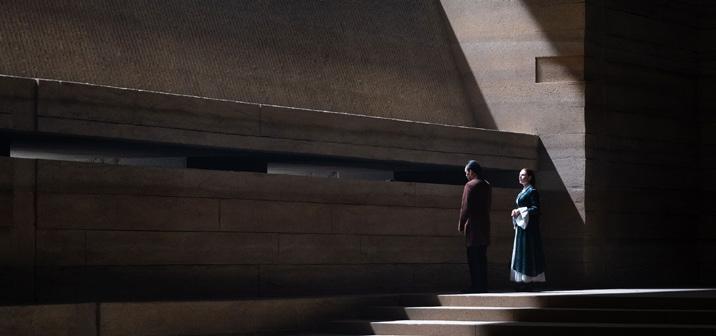

If one focuses more on a human level of survival, looking at resources and technology, one must look no further than Stilsuits- an ecotechnology created by the Fremen , a highly efficient filtration system that cools the body and recycles water lost to sweat. This resource is revolutionary as the body’s movements power the suit itself and allows you to drink the recycled water. This is a very impressive notch in this futuristic fantasy of resources, as it can also be applied to architecture itself within shelters - Dune gives an example of a stiltent- a tent that can keep you safe from the sand, that can be buried by the sandstorms and convert sweat and tears of humans into drinking water, as well as the inflected weather conditions on the tent itself. This is a smart eco technology which relies on the climate of their planet combined with futuristic technology, which in fact could become our reality one day on earth, which can be considered as hopeful survival. Other smart technological resources designed as sustainable pluralism practises are sand compactors - it sends out a natural vibrational pulse through the desert to confuse the Sandworms and guide them elsewhere - this naturally changes the terrain of the desserts and uses the mimicry of natural vibrations of footsteps shifting the desert itself. When humans follow nature and its natural path in Arrakis, it could protect or save a life. This seems to be a recurring theme even on earth, allow nature to take the lead and follow in its path to sustain or survive- with a little addition of future technology we just might be able to get through climate change with resources, shelter and using the climate to our advantage.

RAPHAELA NICOLETTIS: DUNE 7
EMPIRE OF ARRAKIS
STRIPS OF LIGHT IN BRUTALIST ARCHITECTURE
FREMEN SIETCH
FREMEN IN STILSUITS
FREMEN STILTENTS
SAND WORMS
Lastly, we must analyse the agricultural terrain of Arrakis and the Environmental exploitation that followed. Arrakis has a deep rooted terrain, it has a subsaharan sand climate with verbena and incense bush thriving. This is what you would call a nutrient poor landscape. However one can find inbeded in the sands of Arrakis, the spice Melange. “The spice” is primarily known as a entheogen - it helps navigate humans in between the stars for interstellar missions. It is the most valuable substance in the universe. It unlocks prescience , cognitive thinking, ability of heightened awareness and precognitive / genetic memory. The technology used to harvest it is called a spice harvester, also known as a crawler. “It was dropped by carrier ships (known as carryalls) onto spice fields. These machines would then harvest and process the spice off the top of the desert floor.”((schoenherr,1964). These machines are a futuristic take on harvesting machines. They are what you would call eco technologies. They “crawl” a little like how a Sandworm crawls, which gives homage to biomimicry copying the natural sift of the the spice. If one looks more into the environmental exploitation —spice represents a key feature of world-building that assists in tying the threads together and driving through to viewers the ecological message about the interconnectedness of life and exploitation of a resource, which echos in todays day and age, playing a huge roll in the battle of climate change. “Being grounded in real-world historical and social contexts such as the historic spice trade, Middle Eastern conflicts over oil, the 1960s drug culture, spice aids in the world-building process by enabling viewers to immerse themselves in a world that resembles their own but contains humans who have pushed their potential to extraordinary heights through consumption of this precious substance.” (Kennedy,2021) Spice showcases the consequences of addiction and political actions taken to safeguard its continued production. In addition, as a driving force for the narrative, spice helps illuminate the principles of ecology and interconnectedness that underpin the film. Seeing first hand how humans have navigated using and distributing limited special resources, the film sends an ecological message of environmental awareness and a projection of what will happen in the future.

In conclusion, we are barreling toward a future in which survival and sustainability go hand in hand for the futuristic world that is coming. A world of climate deterioration and change. Dune has served as a guide to the apocalypse of climate change and how to deal with the repercussions, showing perfect examples of shelter, technological resources and usage of climate/ natural resources infused with eco technologies and sustainable pluralism. Some eco-technologies found on dune that put this into practise, were seen in two particular categories. The Empire and the Fremen. We saw that the Empire decided to proceed in a brutalist way of closing off nature and creating their own cityscape as one big shelter using eco technologies mostly while prioritising power over the well-being of others. Their resources only consisted of tehcnology for most of the light while completely disregarding natural resources. They blocked out the climate with architecture of concrete and made a wall around their community away from the dunes while trying to preserve 20 palm trees, prioritised over humans.The fremen utilised sustainable pluralism more in the sense of biomimicry , working with nature rather than against it and using low-tech architecture and technology to sustain theirselves. This was seen through the shelters they utilised underground the sand dunes, the sietch and caves. This was soon through technological resources such as stilsuits and stiltents and also how they work with the climate embracing the heat, sun and desert. The Empire used environmental exploitation rather than harnessing the environment, which will lead to the demise of their civilisation while the Fremen will continue to live on and eventually take back control. All in all , once we accept survival sustainability, one needs to practise the way the Fremen live, otherwise the demise of humans and the planet, will be here quicker than anticipated. FIN.

RAPHAELA NICOLETTIS: DUNE 8
SUNSTAINABILITY IS NOT COLLECTING TINS
By Vasiliki Alvanou
U194N3168
9
As most people associate sustainability with household recycling and collection, it might sound difficult. However, what the general public is aware of falls well short of the concept’s true meaning. A world that corresponds to the principles of reducing, reusing, and recycling as well as living simply is one that is considered to be eco-friendly. Achieving sustainability involves using natural resources minimally, recycling or reducing the use of other non-renewable resources, and eventually stopping to use of them completely. This allows us to meet our immediate needs while also retaining and protecting future generations’ needs and enhancing the quality of all lives. Sustainability cannot be a workable strategy if our nations’ priorities are not reevaluated and modified in the direction away from fossil fuels. The economy, society, and environment are the three main pillars on which sustainability is based. An eco-friendly lifestyle is a basis for balance because all of these are interconnected. Historical individuals used resources created by nature to construct their homes. eating everything they’re able to in the neighborhood ecosystem. They were dressed in garments made of leather or natural fibers. Decor and aesthetics became increasingly essential as time went on while people began to become more sophisticated and well-educated. From homes with pitched roofs to tales about the kitchen and how women would style their hair, trends come and go. For the modern individual, decoration has become vital and required. The modernist movement in architecture was all about technology, including the development of heating systems and other innovations for both the home and the workplace. Every object in space had a purpose for existing. Form follows function in all aspects of this era’s design, from the manufacturing of objects to any possible decorations. Le Corbusier developed the five architectural principles during that time in order for residential construction to function better and be more adaptable in a world with advanced technology like cars.
10 VASILIKI ALVANOU: SUSTAINABILITY IS NOT COLLECTING TINS
This was one of the factors that led to the development of the pilotis theory, which allows for easier access to cars inside homes while concealing the connection between the new technological object and the residence. Next in the line is the era of post-Modernism. A movement that looks a bit overwhelmed with all this technology, as result creates some nostalgia and an extra appreciation of some vernacular techniques and materials that people used to build their cities from the existing homeland. One of the most crucial strategies to transfer the past and memories into space is through materials and techniques. There are two sides to the coin, one with vernacular methods and the other with vernacular materials. For instance, R. Venturi’s early 20th-century home in Las Vegas exhibits symmetry. An extremely recognizable home with a pitched roof and entrances on either side of the front door that appeals to human awareness as a house shape. C. Moore’s Piazza Italia is a wonderful illustration. A square that shouts Italy and instantly transports you away from New Orleans. Circular-patterned masonry stones make up the floor, mythological faces and figures ornament the columns, and lovely arches gracefully welcome you within. Also, all of the elements are painted in warm colors that directly refer to any Italian city and have no resemblance to the current location. The goal of that movement was to make people feel a little more connected to their culture and to remind them of techniques and materials that may be employed in future development in new ways than they had previously known. did in New Orleans with the piazza.

Recycling materials is simply one aspect of sustainability; it may be much more, also included in preserving and reusing. The well-known tale of the kid in the wooden puppet, Pinocchio, can communicate some sustainability truths. The story’s main plot revolved around an elderly craftsman who lost his son and took comfort in carving and making furniture out of bits of wood. He made a puppet that was identical to his kid in every way, considering height, build, and even facial traits. Geppetto, who created Pinocchio, was well-versed in woodworking and used it to distract himself from the melancholy he had experienced at the death of his son. Even though the child would never be there in person for him, he attempted and succeeded in making Pinocchio, who had figures that were similar to those of the real child and were fashioned of a material that was equally dear to the craftsman’s heart, similar to what Italians
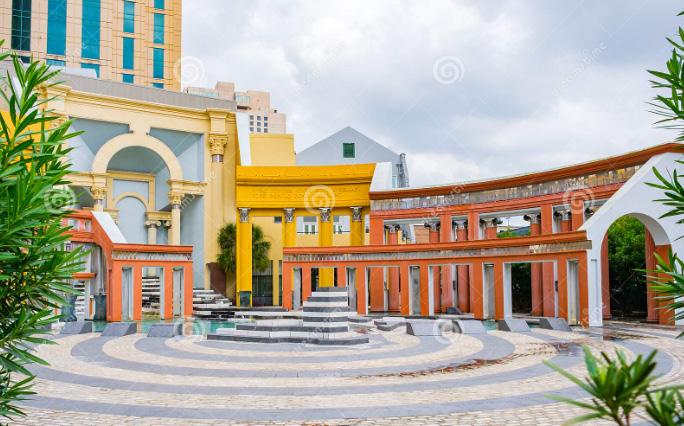
11 VASILIKI ALVANOU: SUSTAINABILITY IS NOT COLLECTING TINS
Also, while the producer team tried to design the frames for each scene and adjust the characters to the story there is some interesting information that relates to one of the three parts of the manifesto reusing. Live-action material for Pinocchio was filmed under direction’s instructions with the performers pantomiming the scenes.

The animators utilized the film as a reference for animation instead of tracing, which would have produced rigid, artificial movement. They studied human movement and then added certain positions to the animation. It’s a strategy that they have done in the tale of Snow White and it was successful. They could just redraw frame after frame without ending because they didn’t have the technology we have today. Additionally, they modified a few of the scenes from the Snow-White narrative before using them. This may be thought of as a sustainable action. Reusing something repeatedly while making minor alterations may help tell a story while also saving time and money. Even if technology advances daily, this does not necessitate an increase in productivity. High technical progress can also include reusing what currently exists by just revaluing it and attempting to make it more sophisticated and advanced.

12 VASILIKI ALVANOU: SUSTAINABILITY IS NOT COLLECTING TINS
of future»
Change as technology advances societal norms.
«Our place in the universe is accidental. We are weak and mortal, but it’s not the holy will of the gods; it’s just the way things happen to be at the moment. And this is radically unsatisfactory, not because we direly miss the shelter of the Deity, but because, looked at objectively, the value of human suffering is a dump. The human condition can be changed, and it will be changed, and is changing; the only real questions are how and to what end.
This «anti-humanist» conviction in cyberpunk is not simply some literary stunt to outrage the bourgeoisie; this is an objective fact about culture in the late twentieth century. Cyberpunk didn’t invent this situation; it just reflects it. Today it is common to see tenured scientists espousing horrifically radical ideas: nanotechnology, artificial intelligence, cryonic suspension of the dead, downloading the contents of the brain... Hubristic mania is loose in the halls of academe, where everybody and his sister seem to have the plan to set the cosmos on its ear. Fierce moral anger at the prospect is the weakest of reeds; if there were a devilish drug around that could extend our sacred God-given lifespans by a hundred years, the Pope would be the first in line. We already live every day through means of outrageous actions with unforeseeable consequences for the whole world. The world population has doubled since 1970; the natural world, which used to surround humankind with its vast Gothic silences, is now something that has to be cataloged and cherished.»

Nowadays, social and personal sustainability is becoming an essential issue to settle. People like to try to predict the future while exaggerating crises in proportion to years of perspective. In the article, the tendencies of the end will be analyzed with a focus on the sustainability of man as an individual and society changes.
Cyberpunk, as a genre, is close to antiutopia; however, it always focuses on technologies and how influential they can be. Works of cyberpunk make it possible to see different views on how humanity will embrace technology and see it solving the crisis of conjunction as a current social crisis but in a futuristic environment.
Fusion with technology creates a cyborga «Meta- human»; in conjunction with technology and a new society, a « MetaSociety» will appear.
But what are «Meta-human» and «Meta- Society» would be? Would they become more sustainable in comparison to us? This questions article will give you the answer.
Article Outline:
1. What is Cyberpunk?
2. How real is cybernization?
3. Problems of «Meta-human.»
4. Crisis of «Meta-Society.»
5. Conclusion
«Infusion
Maxim Murashov U194N2499 13
Bruce Sterling, essay «Cyberpunk in the nineties.»
What is Cyberpunk?
Cyberpunk is a genre of Sci-fi invented by Bruce Bethke in 1986. It shows a decline in human culture while technology is on its pick. Modern innovations are becoming easy to get, which leads to their abuse. The government is corrupt and does not care about minorities or the social life level of citizens. Usually, the main hero of the stories are marginals: cyborgs, or hackers who oppose injustice. Cyberpunk as a genre appeared as a reaction to futuristic utopias, which were popular at the beginning of the 19th century. The leading popularizer of cyberpunk was Mal Gibson, known for his works: « Dune,» «Neuromant,» etc.

Cyberpunk observes conflicts between AI and humans, Humans and corporations, and Privacy and Private in the technology world.
How real is cybernization?
Every day millions of people raise their heads into the sky with a dream of changing their bodies and becoming more agile, more robust, better looking, and more sustainable as a result of human beings. All these dreams become closer to reality when digitalization is a part of the dialog. Though an overall understanding of it is possible, not many people can say how exactly we will fuse with technology. Fortunately, the article will try to answer the question. However, first of all, we need to understand what is cybornization. Cyborg - coming from cybernetic and organic. Means a fusion of both. Technology is applied to an organism to restore or enhance its functions. Such technology can be implanted in organs or wearable technology as an exoskeleton. Synonyms - augmented human.
Unfortunately, today most of the implants for invalid or other disabled individuals are far from being called efficient or capable of enhancing human abilities, though who knows how it would change in a few years. One of the breakthroughs is a prototype design by Neurolink.
The sensor can be demonstrated to microwires and micro cheap with 16 384 neuro waves receivers, allowing multifunctionality.
The stationary base is another part of Neurolink’s device. It is a computer to host AI which decodes neuro activities

Neurolink- American neurotechnological company founded by Elon Musk, planning to develop and manufacture implantable neurocomputer interfaces. The company is developing an augment to help paralyzed people using computers. Their goal is to create the most efficient communication between man and machine. They developed sensors that can catch electronic impulses transmitted by neurons in the human brain. Currently, the development team can create a robot to insert sensors, which are microwires, in brain safety. They also found an efficient way ( 3 points) to read neuro waves and make a computer prototype to decode them. The device can be separated into two parts: a sensor and a stationary base connected by Bluetooth. They senreceiveeive a river of your brain signals; it will be applied or replace a part of your skull. Sensors can be charged wirelessly; in two years of development, creators achieved minimum defense in powering efficiency between turned-on and turned-off devices. The sensor is also safe. The temperature of a machine is between 36-38 degrees which makes it safe for a human brain.
into commands for the PC. It also catches your thinking patterns to allow better and faster control over established orders. To control the PC, Neurolink proposes a cognitive keyboard and cursor. The AI is currently learning how to detect thinking patterns for writing letters. Also, the computer is quite effective in detecting cursor control. In other words, Neurolink developed a device to work with computer interfaces by just using your neuro waves. Their progress and all technologies were tried on six baboon monkeys which allows us to emulate its efficiency in humans.
Neurolink shows the possibility of working with the neuron system of humans by catching its signals. Still, the founder of the company Elon Mask talks about turning this algorithm to allow us to electronic code signals from a device to transfer to bain’s neuron system to allow even more abilities. Maybe one day, we could implement artificial eyes in a man.
So, how close is cyberization? To answer that question, I would interpret Elon Mask’s words in his interview with Joe Rogan; those who use smartphones are cyborgs already.
14
MURASHOV: INFUSION OF THE FUTURE
MAXIM
Problems of «Meta-Human»
To explore the human scale in the cyberpunk world, a fictional story would be used as an example. «Ghost in the shell» is a Japanese manga and anime written by Masamune Shirow in 1989. The story is set in the mid-21st century and is about government counterterrorist organizations. The story’s main protagonist is major Matoka Kusanagi, a complete cyborg. After being involved in an accident and having her body hardly damaged, she became part of a government program, having her body modified for a spy and military actions to become a counterterrorist.


Being a complete cyborg allowed her to have some no-human abilities. The modified body was a lot stronger than the normal one, as the altered vision was way sharper. Her cyber brain was faster, allowing her to communicate with gadgets without any connecting elements. Also as her thoughts could be translated into the network.
In her slice of life, there was no significant difference in comparison with normal humans, if we are not taking into account that she has no need of food for energy but still needs to sleep. Her room was just a bed with an auto-opening window to wake up to natural light and a big bathroom where most of the space was given to a shower room, where the protagonist was having their time thinking. It is important to note that Major Kusanagi was, first of all, a SWAT member, so most of her augmentation has a proposal to kill or assist her in killing people. Not to make her life extremely comfortable.
In the anime film «Ghost in the Shell» 1995, the central aspect of the film was to show how humans, by complete cybernization of their own body, will come closer to artificial intelligence and even can be fused with it to create an entirely new type of creature. Thought the author is not making humans as a program, nor the program as a human. According to what was shown in the film, Meta-human, will not be something completely different from what we are now. However, basic needs will be reduced. But the urge for entertainment, thinking, and sleeping still be actual. People will become more adapted to doing «the job,» but it won’t have a global impact on their lives outside of the workplace. Humans will never be equal to robots, even if 100% of their body is mechanisms.

15 MAXIM MURASHOV: INFUSION OF THE FUTURE
Crisis of «Meta-Society»
What can our society become? This question is always relevant. But how do game designers from CD Projekt Red, the game company that published Cyberpunk 2077, answer the question?
Before the answer, let me justify the choice. Cyberpunk 2077 is an actionadventure game with an open world, done in 2019. Open world genre means that the player is not restricted to current locations and can travel all around the design map. That makes «Night city,» where the action is happening, detailed and well-made. But we will not be discussing the game itself. Let us focus on an anime series Cyberpunk 2077: «Edgerunners». Done by Rafał Jaki, author of Cyberpunk2077 universe, and screenplayed by Masahiko Otsuka.

Anime shows the world of high-tech and low life in a new, very detailed resolution. The protagonist of Cyberpunk 2077: «Edgerunners.» is David Martines, whose life story represents a shown society. The main power in the world of Cyberpunk 2077 is in the hands of corporations and big companies. People who are not lucky enough to adopt to

Their trends, or to be valid, are through into the streets of «Night City» to refill numbers of marginals, bandits, and drug addicts. In a system done by corporates, people are forced to fight each other to build a successful career. Cybernisation is an essential tool of the race and is quite accessible, though have substantial side effects on a user. People not ready to put their bodies and health on the line are losing their jobs. This is an example of forced cybrrnization, the tendency which can appear in the future when technology is highly assessable. The reality where to be natural humans will be a shame. It will not worth mentioning that Rafał Jaki is also making some predictions of some future tendencies. Such as the automotive industry crises, the massive rise of private and corporate aviation, and the tendency to completely ignore climate change and greening. Society will become multicultural, and technologies will be the primary resources where cybernization will become a central inclination.
Conclusion
All in all, what will be the result of the fusion between us, humanity, and technology, according to Cyberpunk?
Resources:
Cyberpunk: Edgerunners. Directed by Masahiko Otsuka. NETFLIX, 2022.
Ghost in the Shell/攻攻攻攻攻. Directed by Mamoru Oshii. Shochiku 1995
https://www.cyberpunk.net/en/edgerunners
https://en.m.wikipedia.org/wiki/Cyborg
Youtube. «Neurolink Show and Tell, Fall 2022»
Taken from: https://m.youtube.com/watch?v=YreDYmXTYi4&t=4231s
People on their own will not change much. They will keep on some of their basic needs, though others will disappear. But with technology being easily accessible new problems will appear, such as forced cybernization.
Though topics the article raised were taken from works of scientifiction, Cybernization is a real thing. It has become a part of our life already, which makes the subject discussed in the article
16 MAXIM MURASHOV: INFUSION OF THE FUTURE
BY MARINOS PAPACHRYSOSTOMOU U221N0381
Issues and solutions to post-apocalyptic worlds are recurring themes in Hollywood blockbusters, which may have seemed absurd at the time. We would have consumed this content in the comfort of our own homes years ago. Not realizing that the problems we face today are the same as the problems faced by our favorite characters from the same series.
We are those beloved characters.
This article will outline the high tech and low tech sustainability tactics used throughout. Real world events and technology will also be compared to the accuracy of the series.
FREQUENT FACES
The 100 is one of many Netflix classics whose subject matter is riddled with cryptic warnings foreshadowing the dystopian future we are approaching. The television series takes place 97 years after a catastrophic nuclear war that virtually eliminated all life on Earth. Twelve space station occupants who were in Earth’s orbit before the war are the only known survivors. A gigantic station called “The Ark,” with roughly 2,400 people, was created when the space stations joined forces. Resources are limited, as are all offenses, regardless of their seriousness or type. One hundred adolescent inmates are labeled “expendable” and transported to Earth’s surface in a desperate attempt to see if it is once again habitable when the Ark’s life support systems are discovered to be seriously malfunctioning.


17
The show gained deserved publicity for its dramatic, action-packed, and scandalous scenes; however, the real, encapsulating factor of the show lies in its realistic and relevant approach to sustainability challenges, the world's current problems, as well as its accuracy in science. The primary motive for abandoning earth is radioactive climate conditions. This is a current threat to our society, as present circumstances have instigated threats over the matter.
The show continues on this theme of relevance as other climatic issues have entered the realm of reality. Season 4, three seasons after landing back on earth, side effects of a nuclear meltdown begin to challenge the survivors black toxic rain and lack of the more covered issue in season 4, drinkable water, When comparing these scenarios with real-world problems, we can critically comment on the toxic rain reports in India and the water conditions in Flint, Michigan, where a public health emergency known as the Flint water crisis began in 2014 when the drinking water in Flint, Michigan, was found to be tainted with lead and possibly Legionella bacteria, Melting ice caps, poor air quality in China, and nuclear threats in current wars are among these.
Upon discovering a nuclear meltdown is unavoidable, members of the group come together to figure out ways in which they will survive. They come to the conclusion that the crashed Ark is the most plausible option. In Season 4, Episode 2, they propose to freeze dry meat until they gather the suitable equipment to start their own sustainable farming system to grow their own food. They come to an agreement about using oxygen scrubbers, which are used to create breathable air in space, to provide sustainable oxygen to the refuge. All forms of scrubbers entail chemical processes that also result in the production of water, which can be consumed or utilized as fuel for the oxygen generator. This method, along with a water gram system, will allow for a farming system to be in place. All of this is possible due to the fact that the arc is located within range of the Ice Nation hydroelectric generator. A hydroelectric generator functions as a water turbine and is presumably used to pump water from the ground.

WORLD DISEASES


MARINOS PAPACHRYSOSTOMOU : THE 100 18
There were 12 space stations orbiting the Earth on May 10, 2052, when the nuclear apocalypse struck. The occupants of the space station believed they were the sole survivors and that Earth was inhospitable. The federation stations made the decision to combine into a single space habitat, the Ark, to pool resources and inhabitants.The individual stations formed the eleven components of “The Ark”, the more relevant components being.


-The Government and Science Station is responsible for artificial gravity using centripetal force. Painted on the station is a US flag, implying that it was originally a United States nation station converted. It was also revealed that this station housed an algae farm, this photosynthetic eukaryotic organism consists of 3 strains being, toxic strain, edible strain and medical strain.
-Argo Station, which was more commonly known as the Farm Station, was The Arks agriculture facility. In this facility edible plants and vegetables were grown for food used by the inhabitants. It is also the station which produced moonshine and medical herbs.



Factory Station, assumed to be the manufacturer of essential items needed by the ark. Items were produced through principles of sustainability as recycled and broken components acted as the main material to manufacture said items.
- Hydra Station, often referred to as ‘Hydro Station’ provides a stance to believe that this station is responsible for water related purposes for example, the reclamation and possibility of aquaculture.
-Tesla Station, assumed to be the powerhouse of “The Ark” for its name, Tesla Station provided the majority of the electrical power.
MARINOS PAPACHRYSOSTOMOU : THE 100 19
THE ARC
ALPHA STATION WRECKAGE ON EARTH
FACTORY EARTH STATION
HYDRA STATION
While, in contrast to the sustainable tactics on The Ark, the survivors on earth were limited in approaching sustainability more traditionally. The series showcases how people who did not escape Earth survived the nuclear war. The first homeworld of humans was Earth, sometimes known as "The Grounders." The first episode of the series aired in September 2149, 97 years after "A.L.I.E," an artificial intelligence that unleashed a terrible nuclear apocalypse.


The majority of the ground recovered, supporting healthy plant and animal life, while air radiation levels remained high, only benefiting those who had developed radiation tolerance. Later in the series, a safe haven in what was formerly northwest Virginia on Earth is home to Shallow Valley, commonly referred to as Eden, the green valley. There lived members of the Shallow Valley clan before the Second Nuclear Apocalypse. Being the only green area on the earth, The Valley played a significant role in Season 5. In part, this was caused by the death wave skipping over the valley. Eden provided growing vegetation and edible berries, and it accommodated birds and fish. The garden was lush, and the sky rained often. When all the majority of technology is destroyed the group has reverted back to traditional means of sustaining themselves by living off the land.
The 100 sets up a framework for possible outcomes in the future but relies on sustainability to prosper under such radical conditions. The Sky People relied on high tech sustainability to simulate an earth like environment in space however The Grounders resulted back to traditional means of sustaining life. The characters proceeded to rely on sustainability techniques as they were faced with a collective of landscapes but relied on farming methods, reusable shelters, and reusable hydraulic systems. The series went further to predict climate disasters. Given the current accuracy of the show, one could assume that it will be possible for humans to live in space, but the question remains, when will we be ready?
MARINOS PAPACHRYSOSTOMOU : THE 100 20
The effect of Climate change

 By Savvas Savvas
By Savvas Savvas
Our world is always changing. The current changes in the climate have come to the attention of the scientists and is one of the main concerns. The term for the climate changes is global warming which causes increase of temperature in different spots on Earth. This climate change is caused by peoples’ activities as for example the burning of fossil fuels, farming and deforestation. In the documentary ‘’Before the Flood’’ released in 2016 there was a massage about climate change and the effects this has on our planet and in human’s life. So, this leads as to the question what is there to be done about it? This article will investigate if it is possible to deal with the phenomenon of global warming by reducing emissions and energy consumption without any threats to economy development. Based on origins of Green Architecture by Phillip Tabb, as years passes the population on Earth is increasing, so more places and jobs need to be available for people in a more modern way in order to meet their needs. This modernism enabled global society to expand the usage of fossil fuels in energy production. According to Tim Donaghy a senior research specialist of Greenpeace international, people have discovered more fossil fuels compare to what we can actually burn. To explain what fossil fuels are, in fact are coal, oil and natural gas oil as it was stated in the documentary ‘’Before the Flood’’ and can be burned to produce energy. The issue here is that in order to gain this fossil fuels, massive forests must be taken away and as a result water and rivers are poisoned and also the ice is melting. In 2010 the U.S National Oceanic and Atmospheric Administration published a report mentioning 10 main indicators of climate change which included sea surface, which means increase of sea level as ice is melting, quantity of sea, the change to ocean heat, overland temperature, air temperature, snow cover, humidity and the size and movement of glacier.
21
According on what is prementioned, Artic is like the air-conditioning for the northern hemisphere of the Earth and if the ice melt that’s going to change what we know until today and the land witch stays uncovered as the ice is melting returns to be a self-heater as the heat from the sun is not reflected back. The change of the weather patterns is going to make floods and droughts more catastrophic. This has an impact on the Earth itself to be warmer and thus seeks to affect the environmental climate and have a damaging impact as it harms animals and in the long-term humans’ life as Rachel Carson stated in Silent Spring (1962). It will be the most dramatic transformation of the environment ever. The arising question here is can we be independent from fossil fuels? According to A. Senem Deviren, on an urban scale because of the issues caused from the conservation of fossil fuels and energy resources lead to the need for more environmentally friendly energy sources to be found. Indeed, when you are in a weird situation you are trying to find solutions in order to stop being digging into the problem. However, this is not the situation with our planet. At the moment, governments are funding the fossil fuel industry with billions of dollars coming out from people’s tax. In order to deal with the problem, these subsidies need to be stop as quick as possible. Politicians can be called the elected leaders but in reality, they are the elected followers that they do what people what them to do and to care only for the good of humanity. A good suggestion to face the problem of global warming came from, Gregory Mankiw in the documentary ‘’Before the flood’’, ‘’tax something to raise the price (oil) and people are going to tend to consume less of it, cut other taxes and increase carbon tax. Can we imagine how the future will look like? By looking at all the arising impacts due to the global warming, it seems like humans are writing their script of a disaster movie, as those movies Hollywood loves to make. The good news is that despite the climate change that Earth suffers, it can be solved with numerous measures with the available sustainable measures.

22
SAVVAS SAVVAS : EFFECT OF CLIMATE CHANGE
However, if people are not able to push government to take actions this will cause a catastrophic impact on the planet and will threat the life as we know it today. So, the environmental problems cannot be ignored. Resend researches showed that by using the available technologies, all the needs for heating, transportation and electricity can be meet by using only renewable sources. This means that we can achieve the goal of the Paris Agreement which is to reduce pollution via prizing carbon and by protecting our ecosystems. The measures that should be taken must be based on ‘’real needs with a diversity of effective solutions’’ as Phillip Tabb mentions in the Greening of Architecture. One of the solutions is to achieved by 2050 is to use only renewable sources as Professor Mark Jacobson of Stanford University suggest. After an advanced computing research that he did with his students, they found out that by using sources such as water, wind and solar the air pollution will be reduced so annual deaths will be reduced too. Additionally, this method will stabilize the price on energy and this will lead the economies of the countries to be more energy independent. For this reason, is clear to understand that governments have crucial role to the efforts for the reduce of global warming and at the same time to the promotion of green societies. Until today more than 75% of the global population is leaving in cities which causes climate change. It is noticeable, that the majority of the cities around the world are not prepared for this climate changes, and this need to be changed. So, the urban structure of the cities is necessary to be climate responsive as Phillip Tabb supports. Natural characteristic can be engaged both effectively and beautifully in urban environments in order to
contribute for greater awareness in order to make cities safer. At the TreePeople organization they have a motto ‘’Trees need people and people need trees’’. This help as to understand that by invest in green societies humanity will have many benefits such as improving physical and mental health and empowered communities and most important to save lives. Thus, in order to achieve this goal people, need to demand by governments to make this goal a priority. A resent realised data seeks to demonstrate the efforts of sub-national governments and the mitigation for global climate changes. The R-20 Yale report which was released in 2015 assesses this data and concludes that these efforts and mitigations can reduce the emissions of 2020 by 1 (one) gigaton. The United Nations environment programs (UNEP) supports that the cities are responsible of global Co2 emissions. If modern cities can be considered as one of the major existing environmental problems, then, the cities are responsible for the solutions to be found. On the other hand, various cities and the local governments have not enough budget for renewable and efficient energy to support green measures therefore they turn to the private sector for finance. Regarding the Carbon Climate Registry in 2015 over 92 percent of the implemented of green actions of local governments were financed by subnational, national and local sources, but with additional funding by both private and public sectors which is important to build sustainable building and to reduces to the mission’s gap.
23 SAVVAS SAVVAS : EFFECT OF CLIMATE CHANGE
As it was prementioned governments need companies on board in order to succeed the fight against the existing climate changes. Latest researches show that the economy of the world is an essential to reach ‘net zero’ gas emissions before the end of the century. Several fundamental changes need to be taken so to achieve this goal along with reducing poverty, inequality and insecurity locally and internationally. These changes include the use of land, the urban design of building and cities. In addition is very important that companies need to go 100% ‘’ clean energy’’. A good example for this statement is Elon Musk who has a goal to reduce this climate changes via production as well as consumption of sustainable energy and as a result to reduce the ‘’risk of human extinction’’ by ‘’making life multi-planetary’’. In regards, to Jim Walker, executive director of Climate Mobilization Fund, there are several campaigns by leading companies in order to support stronger the government’s policies applied to fight back global warming. In Before the Flood documentary, Leonardo DiCaprio discussed with NASA scientists about the twenty satellites which are looking at the Earth every day. The scope of this discussion was about the sea surface temperature, clouds and OCO looks at carbon dioxide in the atmosphere. By the available tools of NASA, scientists can see the surface temperature as measured from space and the poles melting, the Earth to warming and the sea level rising. Astronaut Piers Sellers, said that if humans stop right now burning fossil fuels, planet would still keep warming for a little while before cooling off again and Artic start increase and cool back. This can help public to accept that global warming indeed occurs and by applying effective measures there is a possibility to repair the existing problem of climate changes.
All in all, climate change is a main concern for the scientists, as people need a livable and healthy environment. Indeed, the world needs solutions which deal with the effects of climate change, such as food security, species extinction and several other crises. To achieve this, significant investments and effective measures need to be taken by business and governments. It is important to bear in mind that even if we succeed in meeting the goal, the climate change impacts will continue to exist for the next decades, and this will be the result of past emissions due to global warming. Thus, people need to alter the emission and consumption paths and to cooperate with the measures applied by governments, to sustain life as we know it.

24 SAVVAS SAVVAS : EFFECT OF CLIMATE CHANGE
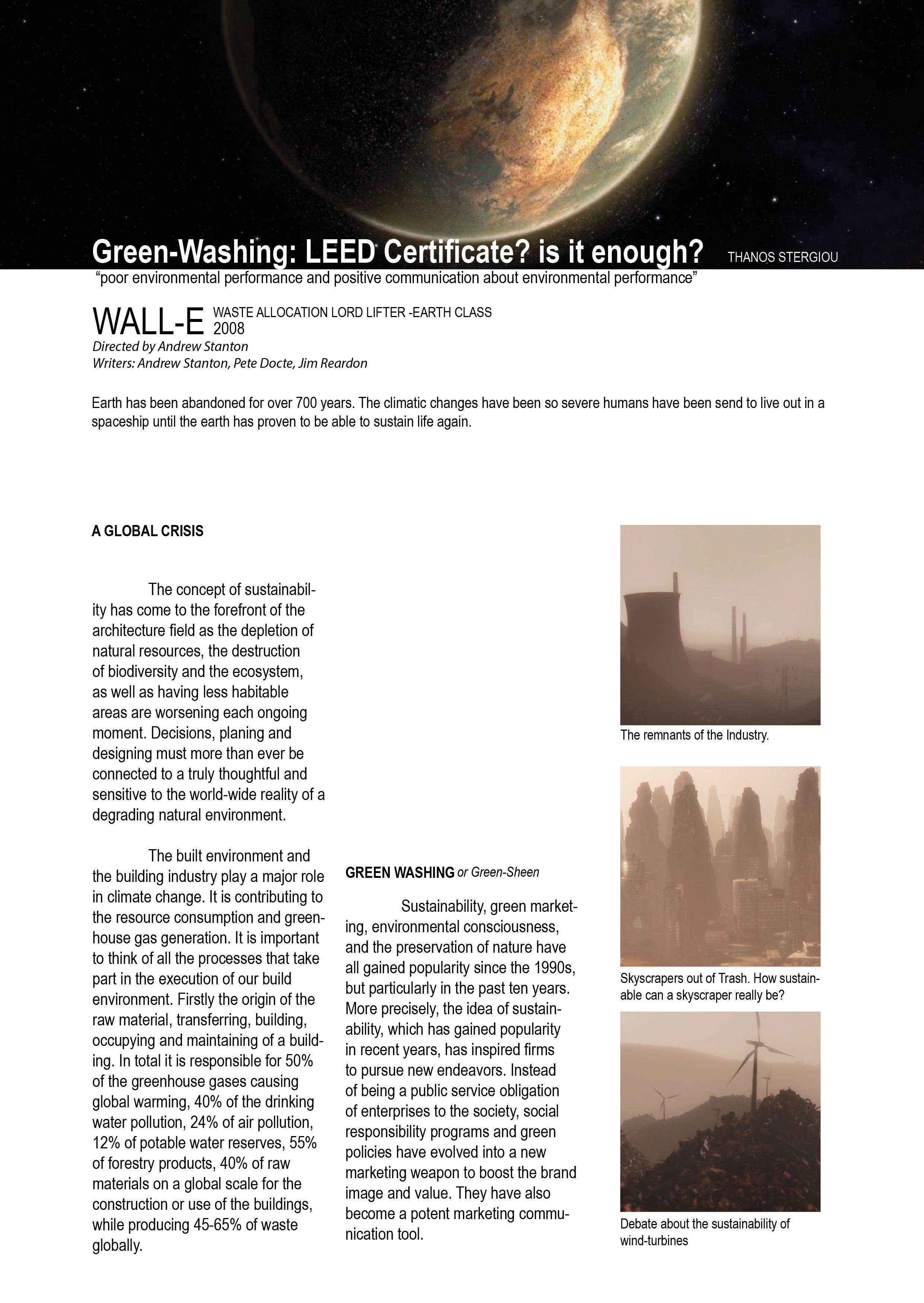
25

THANOS STERGIOU: GREEN-WASHING: LEED CERTIFICATE? IS IT ENOUGH 26

THANOS STERGIOU: GREEN-WASHING: LEED CERTIFICATE? IS IT ENOUGH 27

THANOS STERGIOU: GREEN-WASHING: LEED CERTIFICATE? IS IT ENOUGH 28
How the virus of “The 12 monkeys” could save our lives via sustainable pluralism
 Giannis paraskevas U194N1957
Giannis paraskevas U194N1957
The year is 2035, humankind has been through many hardships and is suffering greatly because of pan demics, massive climate changes, political and physical wars, racial and ethnic disparities, as well as many other challenges. Although every cloud has a silver lining, some clouds are denser than others. In this case, the major problem that is plaguing humankind is a deadly virus that had been released in 1996 and has kept those who have not contracted it underground, in order for them to survive. Nothing matters more than finding a way to resolve this dire predicament and stop the spread of the virus once and for all. However, people must deal with the past, meaning that for a problem to be solved, every scale needs to be investigated and its core to be detected. Can the past help us understand the present and prevent whatever horrible comes in the future? And also, how?
A group of scientists has come together to start their investigation into this matter. They have developed the ability to travel through time and find whatever was never written in history books. Even though as humankind we have most of our history penned down in different sources, there are some things that were never registered. Therefore, the only way for a person to collect information from the past is to physically go there. Additionally, this person needs to be someone who has nothing to lose and is precise enough to accomplish the mission.
Lucky for them, since it is already 2035, technology has evolved enough by now and people can literally travel in time but with the only rule: they can never change what has happened in the past, i.e. their fate or destiny remains unchanged. Also, these scientists know someone who has been in prison for years now and is well-known to be effective; a person who has been living in a cell and can bring not just himself but the whole world out of the situation they live in because of the virus.

29
GIANNIS PARASKEVAS: 12 MONKEYS
An important fact to understand is that the virus was manufactured and spread by humans and not by nature itself. Thus, scientists are already aware that they are dealing with a vicious circle, an ouroboros phaenomenon, and that is another reason why they do not want to alter anything from the past, only understand it. They are also nearly convinced that the team hidden behind all this situation is a clandestine group that goes under the name of “12 Monkeys”. However, because scientists are not completely sure that these are the true cause, they are willing to go back in time and dig deeper, so that they try to investigate the truth and eventually produce the cure for the virus.
Scientists knew that to save humankind they had to understand the bigger picture. The virus itself is not the only thread to humanity, but just the peak of what they had to deal with. Let us assume that their plan was successful, and they eventually managed to make people immune to the virus, then what? What guaranties that there is not going to be another group, another person who will commit this terrible crime again? What other issues could potentially come afterwards?
“ if we could be twice young and twice old, we could correct all our mistakes. ”
Before we try to answer these large-scale questions, let us have a look at the smaller-scale questions; and perhaps the best way to start is by examining the scientists’ plan to find the cure for the virus.

The name of the aforementioned prisoner is James Cole, and he is doomed to be sacrificed right from the start, from the point when the scientists decide that he is the one for the job. Although Cole is known for his precision and dedication while accomplishing his tasks, he is also dealing with his own ghosts from the past: he keeps having the same dream over and over again, and this will haunt him forever if there is not going to be any large-scale change, just like climate change. He suddenly hears a gunshot (the fuse), he then sees a young boy (his younger self) watching a long-haired man covered in blood fall on the ground (his adult self, after everything that has happened); then, a woman is running towards that bloodied man shouting “NO!” (The humankind). Realising that he is imprisoned in an infinite loop of his own death.

30 GIANNIS PARASKEVAS: 12 MONKEYS
The idea behind the scientists’ decision to send Cole back to the past is that by immersing him in that reality he will be able to understand the situation more completely and that he will be able to change everybody’s perception of reality, thus changing the lives of everyone around him. By understanding the past, he can better understand the impact it has on the present, and in the same vein people will be able to understand the impact of their present actions on the future.

GIANNIS PARASKEVAS: 12 MONKEYS 31
Another question that is hovering is whether one can retain his or her sanity while living in an insane world, and whether Cole is crazy or the world around him is. We can take this parallelism and apply it to present-day humans and the environment: Can we maintain our modern lifestyle while at the same time we systematically destroy and egregiously neglect the environment? Or should we find the golden mean that will allow us to slightly modify our lifestyle while at the same time we care for and preserve the environment?
One other question that comes to mind is how our intermingling with technology has altered our biological existence? How much has technology interfered in our ability to communicate and interact with others? Can we even keep communicating without using this technology? And, naturally, at what cost to the environment and the way we make use of this environment, for example while planning/ using the urban or agricultural landscape.
The way we handle the environment, natural or built, should be a collective concern, not compartmentalised or viewed only from a local perspective. Humankind should take collective decisions on how to deal with collective situations. Only when we co-operate and collaborate on a global scale can we achieve the best of our ability.

GIANNIS PARASKEVAS: 12 MONKEYS 32
“ Is it mad or are we ? ”
Nature as culture: What can we learn from theAvatar movies

Avatar is a science fiction film released in 2009, directed by James Cameron. The film is set in the mid-22nd century and follows a group of humans who are sent to Pandora, a moon of the planet Polyphemus in the Alpha Centauri star system, to mine a valuable mineral called unobtanium. The humans are at odds with the native Pandora inhabitants, the Na’vi, who are a humanoid species with a strong connection to nature. The film explores themes of environmentalism, imperialism,and intercultural conflict.
The sequel to Avatar, called Avatar: The Way of Water, was released in 2021. It is set several years after the events of the first movie and follows the character Jake Sully as he continues to explore Pandora and learn more about the Na’vi culture. The sequel also explores themes of environmentalism and the relationship between humans and nature, as well as the conflict between the Na’vi and a group of human mercenaries. In the movie, the characters confront the consequences of the actions taken in the first film and must find a way to coexist with Pandora’s native inhabitants.
One of the main conflicts in both movies is the tension between the human desire to exploit Pandora’s resources
and the Na’vi’s desire to protect their home and way of life. In both Avatar and Avatar 2, the concept of sustainability is an important theme that is explored through the relationship between the human characters and the native inhabitants of Pandora, the Na’vi. The Na’vi live in harmony with the environment, while the humans are driven by the pursuit of profit and resources, and are willing to exploit Pandora’s natural resources without regard for the impact on the planet or its native inhabitants. The humans are willing to do whatever it takes to extract this resource, including destroying large areas of Pandora’s landscape and displacing the Na’vi, who have lived on Pandora for thousands of years. The human characters must learn to respect and appreciate the Na’vi’s way of life and find a way to coexist with them and the planet in a sustainable way. Through the course of the movies, the characters come to understand the importance of preserving the natural world and have a sensible understanding of the environment as something sacred (close comparison with metabolist movement 1960s).
The Na’vi, have a deep spiritual connection to Pandora and the natural world. They believe
RAFAEL TSENTIDES
33 RAFAEL TSENTIDES: AVATAR
The Na’vi way of life as a prototype for sustainable engagement with our surroundings
that they have a responsibility to protect and preserve the environment. The Na’vi see their lives as a connected arthroisma of functions and responsibilities towards the natural world and do not believe in exploiting the planet’s resources for personal gain. The ‘tree of life’ in Pandora forest as well as the analogues ‘coral of life’ in the sequel movie is the closest connection to Eywa or the Great Mother, the creator of all things according to Na’vi. The tree, therefore is of highly spiritual value which connects people to all the souls of the planet through its roots and showcases that there is no beginning and no ending but life is rather a collective journey where we are all one. This is the result of incorporating the Na’vi ‘nature as culture’, where people adopt a circular and humble lifestyle that prioritizes the eventual connection with the natural environment and of course the survivability. They are sensitive about their interactions with the natural environment, the input and the output of which will determine their survival in a meaningful way. This culture of survival is opposed to the culture of progress that is evident throughout the modern human history, especially since the industrial revolution and after both world wars. Instead of prioritizing the harmonious co-existence with the natural world and between themselves, human insistence, greed as well as the unnecessary strive for inessential progress and technology led to new levels of exploitation. Essentially, this exploitation is fueled by the vast demands of the modern capitalist society and the ever-developing consumerism culture, where the balance between the human and nature needs is completely lost. In contrast with the Na’vi lifestyle, there is a constant struggle about the content of progress instead of limiting your needs and being critical on new technologies.
Throughout both movies, the main character, Jake Sully, comes to understand and appreciate the Na’vi way of life and the importance of preserving the natural world. He learns that the humans’ pursuit of profit and resources has caused harm to Pandora and its inhabitants, and that it is important to find a way to coexist with the planet in a sustainable way. In the end, Jake chooses to side with the Na’vi and helps

A collective prayer at the tree of life that showcases how nature is deeply rooted into Na’vi culture and religion
34 RAFAEL TSENTIDES: AVATAR
In the Avatar movies, Pandora is depicted as a world with a highly advanced and sustainable society. As mentioned earlier, the Na’vi people live in harmony with their natural environment, using renewable energy sources and traditional building techniques that minimize their impact on the land, while human characters are shown as exploiting Pandora’s resources and disrupting the balance of the ecosystem. One of the key themes of the book “The Greening of Architecture” is the importance of designing buildings and cities in a way that minimizes their environmental impact and promotes sustainability. The book discusses a range of strategies and technologies that can be used to achieve this goal, including the use of biomimicry, passive solar design, and renewable energy sources let’s see where these are evident in the Avatar movies.


One of the most prominent sustainable features in Pandora is the use of biomimicry, which is the practice of designing buildings and other infrastructure using principles derived from nature. The architecture of Pandora is designed using principles derived from nature, with buildings constructed using natural materials and designed to blend seamlessly into their surroundings. This aligns with the concept of biomimicry, which involves designing buildings and infrastructure using natural principles and organic functions. Biomimicry can be used to create more sustainable built environments by reducing the use of energy and materials, and minimizing the impact of construction on the natural environment. The Na’vi houses, for example, are built using a variety of natural materials such as wood, stone, and plant fibres, blending coherently with the environment.
The architecture of Pandora also incorporates principles of passive solar design, with buildings oriented to maximize the use of natural light and heat, and equipped with shading devices and analog technology to regulate temperature. Pandora’s buildings are designed to make use of natural light and heat and reduce the need for artificial heating and cooling. This aligns with the origins of green primitive architecture, which involves designing
INDIGENOUS SUSTAINABILITY
LO-TEK
LOCALITY
35 RAFAEL TSENTIDES: AVATAR
CULTURAL APPROPRIATION
In terms of renewable energy, Pandora relies on a combination of solar, wind, and geothermal power to meet its energy needs. Solar panels and wind turbines are used to generate electricity, while geothermal vents provide a source of heat and energy for many of Pandora’s buildings and systems. Renewable energy can help to create more sustainable and resilient societies by enhancing the energy cycle, reducing greenhouse gas emissions and reducing the risk of energy supply disruptions.
The conflict between the Na’vi and the human characters highlights the importance of considering the social and cultural context in which sustainable design projects are implemented. The book “The Greening of Architecture” also emphasizes the importance of engaging with local communities and taking into account their needs and priorities in the design process. This can help to ensure that sustainable design projects are culturally and socially appropriate and have the support of the communities in which they are located. Moreover, in the sequel Na’vi people have to work together with Metkayina tribe (sea indigenous tribe) and they are introduced to a whole new world of biodiversity, culture and traditions. Both tribes live harmoniously together as well as with the environment around them, always staying connected with the nature around them (the sea world), and prioritizing the collective and highly spiritual bond with the purpose of their existence –protecting the biota. At the end they repel the enemy forces while protecting their habitat, ensuring their indigenous way of life is remained intact and timeless, while their home community building methods are protected and continue to adapt with their surroundings. All the above are an appropriate example of a world where progress is intertwined with humbleness and sensitivity to the habitat that is hosting the people.
In conclusion, the Avatar movies offer a glimpse into a highly advanced and sustainable society that is

founded on principles of biomimicry, passive solar design, and renewable energy. These features align with many of the ideas and approaches discussed in the book “The Greening of Architecture,” highlighting the potential for design to play a key role in creating more environmentally responsible and sustainable built environments., Essentially, in close comparison to the eventual transformation of our built environment, the movie shows the transformation of the human who wants to survive in a hostile ecosystem. Inevitably, the sensible and intimate contact with that environment makes him come to a realisation to love and respect the nature and the planet, realizing how much everything and everyone is interconnected and how vital it is to preserve them. Suddenly, Sully becomes integrant through empirical knowledge and learns the way of the forest, the way of the water, the way of the sand, the way of nature. Most of the time this is what we as humans lack, real involvement, understanding and respect, that could go a long way into saving our future and changing our way of living. Starting with little things and expanding to the built environment around us, lo-tek living and biomimicry building methods can limit our demands and pave the way to the introduction of a nature as culture.

36 RAFAEL TSENTIDES: AVATAR
Mohamed Shokir
1973 Sinai Egyptian War Effects on Energy Policies and Lessons for Today
The first oil crisis that the Western countries have experienced after the WWII exploded in the aftermath of the 1973 Sinai War (6th of October). The resulting oil embargo had a strong effect on the Western economies which had to reconsider their dependency on Middle Eastern oil, increase their own production and apply ways for a more effective use of energy. A similar situation may affect the western countries in the coming months and years as a response to the Russia-Ukraine conflict is having a similar impact on Western Europe oil and natural gas supplies.
Egypt and Syria began the 6th of October at the same time attacking Israel on October 6, 1973, the day of the Israeli Yom Kippur holiday. However, after a few weeks, Israel, with support of its Western allies, has managed to fight Syria back in the Golan Heights and Egypt into Sinai and pushed both the armies into their own territories beyond Israel’s borders (Britannica 2022). To increase pressure on the Western countries supporting Israel to make Israel withdraw from the Syrian and Egyptian land, the OPEC (controlled mainly by Arab countries) has decreased its production of oil and natural gas and strictly limited exports to the USA, Netherlands, South Africa and other Western countries. The effect on the Western economies was a shock that has caused shortages in availability of oil and made the price of oil increase at its peak in 1974 (Brittanica 2022). The price spike of oil has led many Western countries to restructure their energy policies.
From the end of WWII up until the Sinai War, the price of oil in the West was cheap and extremely steady. Businesses, households as well as governments have been used to cheap gasoline and other oil products which created no pressure on increasing energy efficiency. The increase of oil price in 1974 has forced Western countries to seek alternative methods and re-consider gas production and create policies leading to more energy efficiency – car companies have started producing more efficient engines under The Energy Policy and Conservation Act (1975) that has set standards for maximum gas consumption for car models produced in through years (Henderson 1985). The Act has also set highway speed limit to 55 mph on highways as well as various urban and state roads speed limits to limit the fuel consumption (Henderson 1985). As a result of high oil prices, customers in the USA were not interested in large vehicles consuming large gas per gallon ratio. The US car manufacturing companies were not able to shift production from large to smaller vehicles quickly enough which has opened doors for Japanese and European smaller car manufacturers to enter the US market (Rapidtransition 2019).

The oil crisis has also created an interest in alternative fuels and energy production. The war and its resulting energy crisis has led to research and development of wind, solar and geothermal energy technology which was introduced in 1970s.
NASA became the government-funded program of wind turbine innovation and manage to push the industry quickly forward. During the 1970s and 1980s, Denmark have been developing wind energy harnessing and became a worldwide leader in wind turbine manufacturing (Rapidtransition 2019). Similar development can be seen in solar energy with the Solar Energy Research, Development and Demonstration Act of 1974 (Chu and Tarazano 2020) that has led to implementation of solar technology in the US by companies and homes.
Today, the world is facing a similar situation to the oil embargo of 1970s with the Russia-Ukraine war heavily impacting global energy prices. The main impact of oil and gas price increase is felt in the European Union which has been heavily dependent on Russian oil and gas imports (33% of oil and up to 40% of natural gas before the war was flowing to EU from Russia). As the sanctions from both EU and Russia take effect, the resulting price increase have been forcing Western countries to re-consider their energy policies. Most of the renewable energy policies have been in place even before the war as a response of the world to climate change (RePowerEU 2022). For example, the European Green Deal policy proposal is an extremely motivated investment and aimed to making EU CO2 neutral in 2050. Green Deal was approved by EU Parliament in 2020, almost two years before the Russia-Ukraine war broke out that started extreme increase in energy prices. At the start of the war in early 2022 when it was clear that the energy dependence of EU on Russian oil and gas would cause problems, many European politicians were calling for a delay of Green Deal policy as the change towards a more sustainable energy would be more difficult. It was like the EU would have to move to the last resort of coal-powered plants and other fossil fuel facilities.
The 2022 energy crisis has also shifted the European method towards nuclear energy. For several years, there has been a strong
37 MOHAMED SHOKIR: 1973 SINAI EGYPTIAN WAR
debate whether to include nuclear energy as a clean source of power in the European energy mix. Germany, Austria, and other countries were against this due to fears of a similar nuclear disaster that has impacted Fukushima power plant in Japan in 2011, where countries heavily dependent on nuclear energy such as France and Czech Republic supported the addition of nuclear energy as one of the official clean energy sources (The Economist 2021).
Energy efficiency is another important aspect to consider when considering Green Deal. On one hand, there is production of energy whether by import or by own clean production. On the other hand, there is a strong push towards energy efficiency of buildings, transport, logistics and food production. Green Deal offers a variety of support for European countries aimed at building renovation, insulation, pressure on car makers to produce more energy-efficient cars and, mostly, a ban on production of new fossil fuel cars by 2035. In order to make such transition possible, EU has given funds to developing electric and hydrogen infrastructure, electric recharging and hydrogen filling stations (Commission Europa 2022). Even though the rest of the world that has not been impacted by Russia-Ukraine war as significantly as Europe, the European attempt may have a way for development of new technology and infrastructure that could be implemented by other countries. In addition to that, countries such as Egypt and India are already heavily investing in own solar and hydropower infrastructure as well as China, Indonesia and many of other countries. UAE is building a massive floating solar power plant that will be able to not only produce 25% of the country’s electricity, but also desalinate seawater and produce and store hydrogen for fuelling the country (Scene Arabia 2020).
environmental cost. Fracking to harness oil and gas is known to pollute groundwater with chemicals used in dissolving the rock bed, earthquakes and even contamination of drinking water. (Lallanilla 2018). While all these risks can be minimised by technology, fracking cannot be considered a clean energy source as it aims to produce fossil fuels which damage the environment by worsening the already serious effects of climate change.
In conclusion, it can be said that the current energy crisis started by the war between Russia and Ukraine with its effects on global energy prices may have a similarly positive effect on increasing energy efficiency and an even stronger global push towards renewable energy production in the same way the 1970s energy crisis helped the revolution in energy efficiency in the aftermath of the Sinai war of 1973.
Sources:
Brittanica (2022) Arab oil embargo. Available at: https://www. britannica.com/event/Arab-oil-embargo [Accessed 30 December 2022]
Chu, E. and Tarazano, D. E. (2020) A Brief History of Solar Panels. Smithsonian Magazine. [Accessed 27 December 2022] Commission Europa (2022) A European Green Deal: Striving to be the first climate-neutral continent. https://commission. europa.eu/strategy-and-policy/priorities-2019-2024/european-green-deal_en [Accessed 27 December 2022]
Henderson, D. R. (1985) The Economics of Fuel Economy Standards. AEI JOURNAL ON GOVERNMENT AND SOCIETY. JanFeb 1985.
Lallanilla, M. (2018) Facts about Fracking. https://www.livescience.com/34464-what-is-fracking.html [Accessed 27 December 2022]
Rapidtransition (2019) From oil crisis to energy revolution – how nations once before planned to kick the oil habit. https://www. rapidtransition.org/stories/from-oil-crisis-to-energy-revolutio nhow-nations-once-before-planned-to-kick-the-oil-habit/ [Accessed 27 December 2022]
RePowerEU (2022) REPowerEU: Commission steps up green transition away from Russian gas by accelerating renewables permitting. https://ec.europa.eu/commission/presscorner/detail/ en/ip_22_6657 [Accessed 30 December 2022]

Scene Arabia (2020) THIS TINY ISLAND IS NOW HOME TO THE UAE’S FIRST FLOATING SOLAR POWER PLANT. Available at: https://scenearabia.com/Life/Abu-Dhabi-Nurai-ResortIsland-UAE-First-Floating-Solar-Power-Plant [Accessed 30 December 2022]
The USA has also passed a large Inflation Reduction Act under the US president Biden in 2022, as well as healthcare and debt reduction, aims to motivate businesses and homes to invest into renewable energy (Whitehouse 2022).
A question remains how the USA will approach its oil and gas resources. The high oil prices in the aftermath of 2008 financial crisis has launched a movement of investment into new technologies that were able to place USA to no. 1 world oil producer but have also gathered renewable energy investments (Bloomberg 2012). On one hand, this has allowed USA to become less dependent on oil imports but came at a huge envi-
The Economist (2021) Nuclear energy united Europe. Now it is dividing the club. https://www.economist.com/europe/2021/10/30/ nuclear-energy-united-europe-now-it-is-dividing-the-club [Accessed 27 December 2022]
The Economist (2022) Energy security gives climate-friendly nuclear-power plants a new appeal. https://www.economist.com/ briefing/2022/06/23/energy-security-gives-climate-friendly-nuclear-power-plants-a-new-appeal [Accessed 27 December 2022]
38 MOHAMED SHOKIR: 1973 SINAI EGYPTIAN WAR
“Lorax: The Guardian of the forest”
By Charalambia Chacholi U194N2890
39 CHARA CHACHOLI : THE LORAX
Sustainability, a word which every single person on this planet has heard, said or read it somewhere, on a label maybe, but what is that word at the end of the day? Sustainable means that as a person it accomplishes it’s needs by not “harming” the future out there, being more ecological and not depending on the manufacture products that are destroying the environment
The movie “The Lorax” is based on a children’s book written by Dr Seuss where his main focus is the deforestation of Earth which he wanted to educate the younger generation in order to prevent at least the massive catastrophic of Mother Earth Dr Seuss’s book was then cancelled due to the fact that he called out the big companies that are destroying the environment without anyone noticing

Lorax as a character represents all the animals, the plants and every living creature that is living in the forest and their lives are affected negatively by the environmental issues that are happening, that is why they call him “the guardian” of the forest

40
CHACHOLI : THE LORAX
CHARA
The plot is starting with a twelve-year-old boy named Ted Wiggins whose goal was to get a real tree for the girl he wanted to impress and the particular reason for that was the artificial trees and planting that was all over their town. Without the real trees people had to breathe oxygen through some masks that the big companies were selling making tons of money out of it
When Ted heard all that story about the trees past, he felt horrible and wanted to make a change, Once-ler gave him the last seed of the Truffula tree and told him to plant it and to make a movement so that more people care enough to make the change He found out about Lorax who spoke about the animals and the trees who have “no tongues” themselves but at the he could not save them with his speaking, but now with Ted he could at least try again to make the change. “Unless someone like you cares a whole awful lot, nothing is going to get better ” (Dr Seuss, 1971)


The same can happen and to the present day, there is a different of 50 years approximately and the issues are still the same in 2023, there is a deforestation, polluted environment, plastic in the ocean, gas, polluted air, in the Antarctica the ice is melting leaving the polar bears without a home and in the parallel time ocean’s level is rising up, overfloating small islands and cities like Venice, Italy where people need almost a boat and not a car to move around in the city and the particular
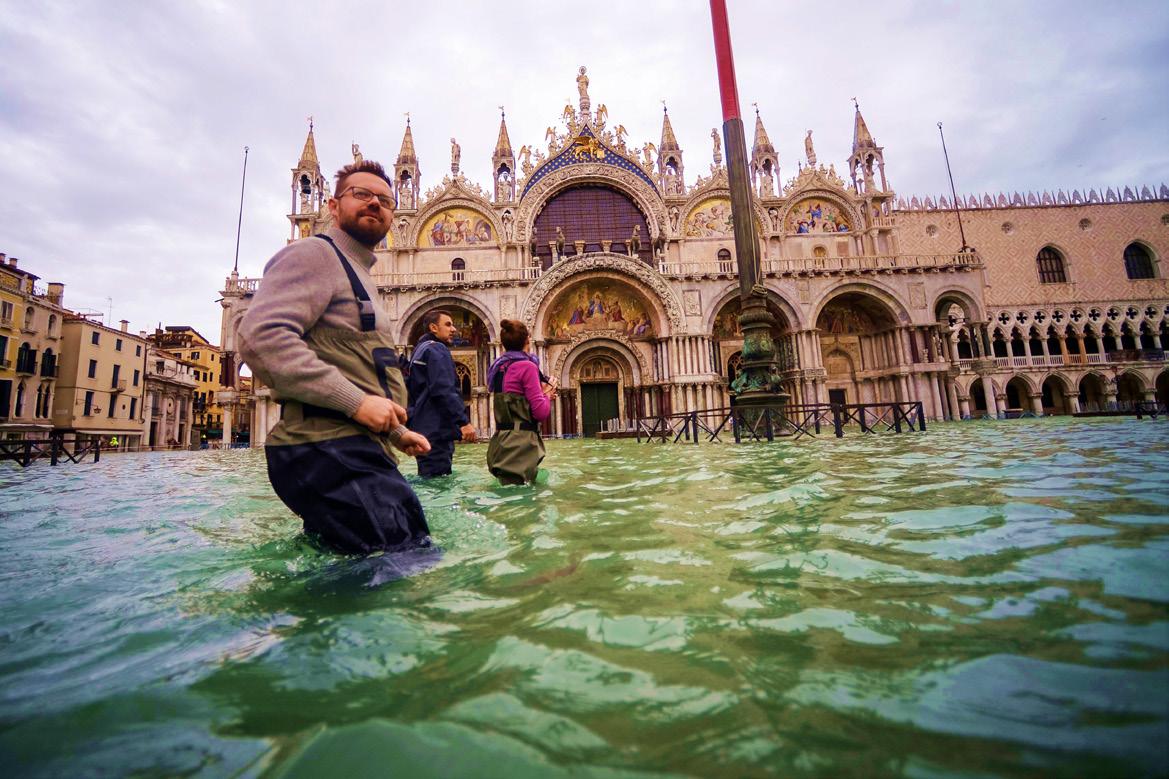
41 CHARA CHACHOLI : THE LORAX
The root of a good knowledge about sustainability and climate change starts from the right education of the kids To save the next generations and to create a livable environment not only for humans but also for the animals themselves there needs to be a change to the way people live, meaning that every single person on this planet needs to start thinking “green”, “If we, as consumers, are so easily swayed by the next big thing, without regard for how it is made, then this is the world we will end up with ” (Dr Seuss, 1971.
To do so an individual needs to make their own research on the products they purchase from companies, because something says that it is “green” it does not necessary means that it is automatically sustainable. A lot of big companies do that in order to outsmart the consumer but with the research of each one it can outsmart at the end the company.
To sum up everything that has been stated so far, if at least one person cares enough to make a change like Ted in “The Lorax” then they can turn around everything, then there is still hope to get out of this climate change, to save Mother Earth like Ted did with his Earth.
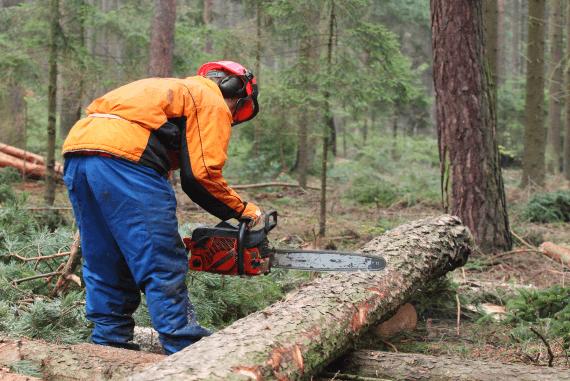




42 CHARA CHACHOLI : THE LORAX
Sun Light Reveals a New Form For Architecture
By Rami Abousada
Never Stop Shining
SUN The
Green energy is a special type of renewable energy generated from natural resources taking into consideration, no production of pollution in the environment, a naturally renewed source, and avoiding any operations which could damage the ecosystem. So basically, any energy source that combines the three different terms clean green, and renewable.
The positive impact of green energy is spread to reach all aspects of life environmental, economic and social. it will replace the negative effect on the environment by replacing the traditional energy resources with alternative environmentally friendly energy, the use of green energy will reflect the results on human and animal health. leads to stable energy prices and less effect of the Geo-political crisis. creates new job opportunities for people. More flexible and less dependent on a core centralized energy Source. present better low-cost solutions for human needs so it will be equally available in all parts of the world for all human beings.
Solar power is one of the most common types of renewable, clean, and green energy because it comes from environmentally friendly self renewed, and non-polluting sources. It spreads to a huge scale in the world, since it is the most affordable energy to be used on daily basis.
Solar radiation (electromagnetic radiation) produced by the sun, strikes the earths surface and varies to each spot in the form of sunlight to the naked eye.
Solar technologies, capture sunlight and convert it to a useful form of energy, either electrical or thermal energy for immediate use and storage.
The amount of sunlight that strikes the earths surface in one and a half hours can handle the whole world›s consumption for a full year Since the sun is a powerful source, and the light generated by the sun is the largest source earth receives. taking into consideration that only %50 of the sunlight that reaches the ground is light, and %45 is infrared radiation, plus smaller amounts of other substances.

43
1973 oil embargo crisis was the first trigger that led the human race to positive permanent solutions saving the environment and ecosystem.

Started in October 1973, when the organization of Arab petroleum exporting countries, plus, Egypt, Syria, and Tunisia started the oil embargo as a response against the United States of America, decisions to resupply the Israeli military. Accompanied by a surprise attack against Israel and the interference of the Russian, and American government.
Negatively, the oil embargo affected the oil price in the USA to jump from $3 a barrel to reach $12. Besides the price increase, different results occur such as the long wait in stations. shortage of gasoline across all the United States gas stations almost %20 were empty.

And one of the most important results of this pressure cart was the political results in 1974 which show the weakness of the consuming community that has been built on some of the biggest countries against the fossil fuels needs. And the other hand, the positive understanding that resulted after the oil embargo, was public awareness of the dependence on fossil fuels, new laws taking the place to avoid what happened in the future, new inventions and research for technologies to find different alternatives to replace fossil fuel and the dependence on middle eastern oil, besides that the biggest impact of the oil embargo showed the negative effect of fossil fuels in the ecosystem and environment.
Jimmy Carter:“Today by directly harnessing the power of the sun, we are taking the energy that God gave us, the most renewable energy that we will ever see, and using it to replace our decreasing supplies of fossil fuels. Solar energy will not pollute our air or water, we will not run short of it, no one can ever embargo the sun or interrupt its delivery to us”.
Solar architecture is an approach to designing buildings of all different types using a variety of strategies and techniques that harness solar energy to improve the way of living reaching energy efficiency and zero-sources consumption buildings.
For a long time ago one of the main concerns of architects is how to reduce the energy that any building requires to create a comfortable atmosphere. The creation of energy-efficient buildings had become an increasing need to create balance which lead architects and designers around the world to take steps to minimize the amount of consumption of energy that new building use. And the emphasis on solar energy and sustainable practices extended globally.
The relationship between architectural design and solar energy is related to both passive solar systems, and the recent innovations in active solar technologies. Throughout, these two different types of solar design are re-creating new thinking for cities and architecture around the world.

Sun Light Reveals a New Form For Architecture: Rami Abousada 44
Solar Architecture Development: Has been in existence since centuries ago. ancient Greeks, build several solar cities throughout using their knowledge (Olynthus). And in the 11th and 12th centuries, pueblo Indians of North America build several solar communities.
However, these times the development of solar energy merged with architecture without specific knowledge of the qualities and benefits of sunlight energy. In the late 1940s to 1970s due to the cheap price of fossil fuels energy solar energy, materials, and architecture seem expensive, and the awareness of the community for reaching the level of energy. Comfort came to the last end of that.
After 1994 solar energy programs and technologies started to have a potential respective to compete with any other energy source after the promotion and research that come up with the gnu inventions that were carried out by various architects and builder specialists.


Since solar power and architecture are combined, so the passive form of solar design should be modified in building design to create a mixed system between passive and active solar technologies. Therefore, it is important through the design stage in the building to predict how this structure will behave. Through different strategies such as orientation, sunlight accessibility, And insulation.
nowadays, and after the new direction that architecture is looking towards clean renewable, and green energy in their designs. There’s still a problem with that facing this revolution of independence from fossil fuels ruling. the green project construction and whole different stages are still consuming fossil fuels and around %80 of the used energy in any new building is dependent on fossil fuels to reach the zero consumption design at the end.
In conclusion, green energy, in general, is the future of the world by offering a true alternative source to replace fossil fuels, the benefits of green energy resources, are not only limited by the impact on the environment and human beings but also economically by creating thousands of jobs. By developing different green energy systems, we can give the next generations a better sustainable future, without damaging the world we all live in Solar energy is an important option to consider for being economical and environmentally friendly, to save the earth from extinction.
Sun Light Reveals a New Form For Architecture: Rami Abousada 45
Passive solar systems refer to the solar energy usage in buildings by direct exposure to the sunlight using design elements, strategies, and materials without the evolving of any mechanical or electrical components. Therefore, the design elements and materials can reflect transmit or absorb solar radiation. This system is simple and more efficient in comparison to active solar technologies.

The complete passive solar design contains five main elements:
1- Collector: the element or material responsible for the accessibility of sunlight to the building, should face the true South within °30 and not be shaded by any other building or trees.
2- absorber: act like a storage element for solar energy, must face the direct path of the sunlight.
3- thermal mass: basically, and materials below, and behind the absorber element with an unexposed surface, retain and store the solar energy.
4- distribution: strategic methods to circulate the solar energy from collectors and storage points to different areas of the building. Mainly the three natural solar energy transfer modes are conduction, convection, and radiation.
5- control: the element responsible for controlling solar energy flow to the building, including sensing devices that help open and close the vents, dampers, or shafts.
Active solar technologies refers to a required set up of mechanical and electrical equipment to capture and store, solar energy for future use. Active solar systems use sunlight energy to heat fluid in two different shapes either liquid or air transfer it to a storage system for later use it works on the principles of thermodynamics.
The main three essential components of an active solar system are:
1-solar energy collection: commonly a flat plate collector, simply cover the glass insulated box containing black absorber plates to absorb solar energy and convert it into heat.
2-solar energy storage: it could be a water tank or thermal mass for liquid systems or rock binds to hold air for air systems.

3-solar energy distribution: different equipment for different systems, for example, pumps for liquid systems, or fans for air systems. Helps to circulate the energy around the whole building.
One of the important applications for active solar energy technologies is converting solar radiation into electricity, using photovoltaic cells. The generating of a small electric voltage happens when light strikes the junction between the metal plates. single photovoltaic cell generate around 2 watts. Therefore, by connecting a larger number of individual cells as in solar panels, the generated watts of electrical power will become enormous. So basically large number and dense assembly of cells is required To produce the needed amount of power.

Sun Light Reveals a New Form For Architecture: Rami Abousada 46
CANNED LIFE |
Abstract
An environmental disaster surrounds us Our climate is constantly undergoing significant changes This essay explores the influence of climate change on the built environment to develop ways to comprehend environmental changes, increase awareness, and ultimately mitigate the impacts of the disaster ahead of us Through architectural design, environmental concerns ought to be addressed. Three factors influence the design and construction of buildings. The first one is how our architecture can be innovative in optimizing our current technologies to achieve high building performance The second one is how can we optimize our energy resources to fit the needs of our environment first, and how can we design our architecture to be satisfied with those optimized resources? The third one focuses on how we create architecture that would positively and intelligently adapt and change along with our rapidly changing climate These topics will be analyzed through various environmental, social, and cultural lens
Introduction
Architecture has more significance in peoples’ lives than most designers may believe It influences how we live, how we think, and how we see the world Today, the world has become a focal point for climate instability, one of the most pervasive global issues affecting our daily lives Human activity has been a significant factor in these recent environmental changes. Several questions may emerge from this
Can we combat global warming using our expertise, i.e., architecture?
It is crucial to emphasize the risks and consequences of climate change and how dangerous it is to live in a society where these issues are not addressed properly since environmental disaster is already occurring around us and disrupting our everyday life Architecture design briefs and statements, therefore, should include provisions that seek to raise awareness of climate change via data-collecting techniques and the study of the performances of created structures. As we are twenty years behind the objectives established in the Paris Agreements signed eight years ago, data and information are offered to engage architects, designers, and global citizens with the imminence and gravity of the situation (Falkner, 2016) Philosopher Antonio Gramsci once said, "Pessimism of the intellect, optimism of the will" (Antonini, 2019) urging us to perceive the world as it exists, not as we may like it. A world where utopian concepts are not viable solutions to our current problem. We must begin creating for the real world since only then can designs serve our planet and its inhabitants
THE REDEEMER FROM PRAGMATIC UTOPIAN ARCHITECTURE & THE REBIRTH OF THE UNCONTAMINATED EARTH
How does architecture alter our way of thinking about climate change ?
Causes and Effects: Overpopulation & Climate and Consumption
When making architectural plans, there are various factors to consider, most importantly sustainability in the broader sense, starting with energy, water, land, and biological resources. From start of time, explorers and settles exploring the world whipping out species and slaughter the ecosystem Moreover, “ The difference now is we’re knowingly doing this; it's just on a much larger scale” (Stevens, 2016) The number of humans sharing these resources is often underestimated, although being a crucial consideration. The increase of world population has risen from 1 billion in the 1800s to around 8 billion today (Roser et al 2013); over the past 50 years, the world population growth rate declined from around 2% per year to just under 1% per year (ibid), yet, the decrease in the percentage has not lessened the overpopulation impact on the climatic situation
 The Garden of Earthly Delights: Hieronymus Bosch
The Garden of Earthly Delights: Hieronymus Bosch
47
‘A paradise that has been degraded and destroyed’ DiCaprio
Is the next lethal climatic disaster ready for release?




Strangely enough, climate change is our greatest hope for survival There is a universal agreement on the magnitude and pace of global warming, where 195 nations signed the report that the IPCC published regarding climate change, as well as the areas that will be most severely impacted and the future prediction (Melton 2018, Bremmer 2022)


Research published in the Journal of Industrial Ecology (Ivanova et al 2015) indicates that human consumptions account for more than two-thirds of global greenhouse gas emissions and between 60% and 70% of overall material, land, and water usage. This emphasizes the need to take responsibility for our actions as consumers and realize how habits impact the environment and accelerate climate change
WORSE & WORSE
In the Environmental Impact Assessment of Household Consumption, the research revealed that around 80% of the climatic effects resulting from consumption are not caused by direct practices such as overconsumption of water resources or driving a vehicle, as is often believed, but rather from the transport or production of these items. For example, the research demonstrates that the water used to produce frozen food is much more than the amount used for daily domestic activities The study concludes that the wealthier a nation is, the more influence its people have on the climate, since the wealthier its residents are, the more they buy things that have a detrimental impact on the environment (Ivanova et al 2015)
The situation humanity faces today requires a more flexible and adaptable approach The climate change, which might kill hundreds of millions, compels leaders to cooperate on information, costs, and obligations As a direct consequence of the European Green Deal's, unparalleled commitment to carbon-free energy, Europe has emerged as a worldwide leader in climate policy. The European Commission has effectively persuaded hesitant member states to support climate change by giving climate investment a greater priority in its budgets (Bremmer 2022)
The world's most significant polluters are China and the United States, as proven by the assurance presented by large firms (Stevens 2016 , Bremmer 2022) The highest percentage of greenhouse gas emissions per capita globally, with a total of 18 6 tons of CO2 equivalent to a carbon footprint produced by The United States. Researchers used this unit to illustrate the effects of several greenhouse gases This significant carbon footprint results from the dominance of the automotive sector as the primary mode of transportation The research revealed varying outcomes for specific nations, mirrored the electrical mix and fuel sources utilized to produce energy. For example, Norway, France, Sweden, and Japan have much smaller carbon footprints than other nations with similar economic levels when fossil fuels were used to create electricity instead of nuclear power Surprisingly, in nations such as Norway and Sweden, more than half of the environmental consequences were attributed to external imports, as fossil fuels were used to manufacture imported goods (Ivanova et al 2015) ``
The significant growth in electricity production is linked to the contemporary phenomena of mass production and the rise in demand for energy.
( )
‘Mordor from lord of the rings’ DiCaprio
Difference Between Methane & Carbon Dioxide as a Greenhouse Gas?
48 Alisar Bshara: Canned Life
Methane, a greenhouse gas similar to CO2, has a climatic influence 23 times that of CO2. The majority of the world's methane emissions are created by livestock farming..
Architecture And Climate Change

It is important to consider the DESIGN PROCESS to give sustainable architecture a new lease on life. Using various architectural and climatic philosophies, and comparing different historical periods illustrate how climate change has impacted architecture Despite the notion that technology comes with its costs, it nevertheless, has shown a green path to a more sustainable living. However, ecologically responsible design comes with a wide range of concerns and objectives The urban and rural design considers numerous climatic elements and manipulates the high-tech building process to generate architecture that is as environmentally friendly, green, and sustainable.
Environmental ethics has neglected the built environment and architectural design Thus, ethics and morality have yet to be discussed in a fast-expanding language of sustainability that emphasizes quantitative models of environmental innovation rather than environmental ideals Pragmatism may give an intellectual and moral framework for linking sustainability to building plan, erection, and utilization. Pragmatism's contextual diversity, focuses on experience and practice, and elevated esteem for the community's political value shifts the conversation fare from predetermined and universal ethical and technical standards Sustainable design is a "co-evolutionary" social activity involving many human and nonhuman constructing and using complex architectural artifacts (Farmer & Guy, 2010). Beyond the basic "how to" disputes, the goal is to deepen sustainable design practice via social or philosophical problematization The design should be reconsidered by researching sustainable structures in the plural
Architectural Design Options: Adaptive Architecture
Charles Darwin revolutionized not only biology but also man’s thoughts by claiming that "Adaptation is the evolutionary process whereby a population becomes better suited to its habitat This process takes place over many generations and is one of the basic phenomena of biology" (Darwin, 1859)
The term ‘a d a p t a t i o n’ describes an architectural item's physical and morphological alterations. These morphological alterations often the result of architecture's evolution in the social field, technical outcome, and industry Throughout history, several transformations have impacted the perception of how architecture is made and perceived The structural condition responds to the period in which the architectural objects develop and comprehended. These modifications are the consequence of adaptation to changing eras, societal standards, economic circumstances, the demands of the inhabitant, and climate conditions. The environmental changes occurring over a defined time length may be seen as a distinct factor that influences an architectural artifact and leads to local adaptation Thus, climatic changes that occur over a more extended period would generate forces altering the architecture throughout that time in order for the architectural item to pull through the changes and remain stable.
Carbon taxation?
Adaptation is regarded as an elongated process in architecture; It shapes and reshapes various ages and generations, with numerous advances in the human cognitive process, critical thinking abilities, technology, and economic support, all contributing to the architecture's flexibility The surrounding natural and climatic influences continuously affect the way of life These forces are in constant flux, with varying degrees and variations of dynamic variables. This impacts their lives by putting them in a perpetual state of change The architecture and the places we inhabit will inevitably undergo modification This transformation is swifter and more significant than the change our climate is experiencing For example, building skins consist of horizontal and vertical parts that shield the building from external environmental influences, preserve the comfort of the building's interiors, and provide structural support A building's outer skin provides stability, regulates air pressure, and shields the inside from bioclimatic variables such as heat, sunshine, wind, and precipitation. As they serve as a medium through which TECHNOLOGY may be incorporated into the building system to react and respond to changing climates, building skins are a crucial component in the research and investigation of adaptable architecture. Consequently, the primary properties of an efficient and robust building skin are its capacity to alter and respond to energy transmission across the building envelope through amplification, attenuation, regulation, entrapment, or rejection (Verma, 2013).
49 Alisar Bshara: Canned Life
Solutions to climate change are expensive, and actions speak louder than words. We need accountability to trust that words will be translated into the necessary actions. As a result, a carbon price is advantageous to us. As fundamental economic theory predicts, a more outstanding tobacco tax has decreased cigarette smoking. Professor Greg Mankiw, author of Contemporary Economics, Harvard University professor, and former Chairman of President Bush's Council of Economic Advisors, advocates tax increases. This does not have to be a tax increase but rather a tax transfer offset by a decrease in payroll taxes. The most pressing concern may be social responsibility
Conclusion



We, as architects and planners, need to focus on raising awareness among public at large by providing statements that shed light on climate change issues that architects should tackle Therefore, taking reference to the current research work done to cope with those issues and providing statements about the additional work architects should conduct to address and resolve before it is too late. Climate change is real; an important issue that can also be addressed politically by decision makers and influencers spreading awareness and delivering clear concrete advices The utopian movement continues to exist on a social, political, and technical level today. The utopian architecture was believed to be too ambitious and lacked the necessary level of detail to be constructed; it was seen as unrealistic However, the intent of bringing society together in all aspects is the intention we are all seeking. With the submission to the difficulties, people may feel more at ease to be informed that despite our obstacles, we can still do better Although the attempts of the great visionary have not gone in vain, it has become a vital tool and case study to look up to and learn and improve from. For example, releasing light bulbs and reusable bags may encourage individuals to buy energy-efficient products and use public transportation instead of driving (Stevens, 2016) The conscious awareness process made the public optimistic and comforted that their efforts would be recognized. It is essential for a broad movement for everyone to start to join the 2030 commitment that was adopted by the AIA, where all new constructions, developments, and major renovations should be carbon-neutral (Melton 2018) Then emphasize the significance of adapting and retrofitting existing buildings that do not fall as part of that challenge, how the materials for those buildings are a massive part of the carbon footprint of those buildings, and what we can do to reduce that footprint
Moreover, we must stress the importance of pursuing renewable energy resources, as other sources are bound to run out someday A solution could be also reconsidering our living and constructing methods that are approved to be disastrous.



What & how can we learn from the architectural history of adaptation?

SOLAR AND WIND

Can the skin of a building for example not only provide for comfort but also for the energy needed in a building, thus leaving zero impact on the environment?
FREE ENERGY FOREVER
We might as well need to reconsider evolution theory as not a straight line going always forward, but rather, a twisting and branching line showing a multitude of potentials and possibilities As a matter of fact, technological evolution backfired on our dreams of prosperity, health, and wealth and left the climate with unparalleled losses. Perhaps, we need to reconsider less technology and machines in our lives, and more passive energy and innovative zero-sum game ecological designs In short, the changes in human behavior (especially consumption), the advancement of technology (innovative green materials and techniques), and the adaptation and modification of space and architecture (socio-spatial-environmental elements) are vital for realizing an ecologically sustainable way of life
50 Alisar Bshara: Canned Life


climate
Amr Shokir: global climate change 51
change


climate change Amr Shokir: global climate change 52


Amr Shokir: global climate change 53


Amr Shokir: global climate change 54






















 BY RAPHAELA NICOLETTIS U191N0425
BY RAPHAELA NICOLETTIS U191N0425



































 By Savvas Savvas
By Savvas Savvas






 Giannis paraskevas U194N1957
Giannis paraskevas U194N1957































 The Garden of Earthly Delights: Hieronymus Bosch
The Garden of Earthly Delights: Hieronymus Bosch
















